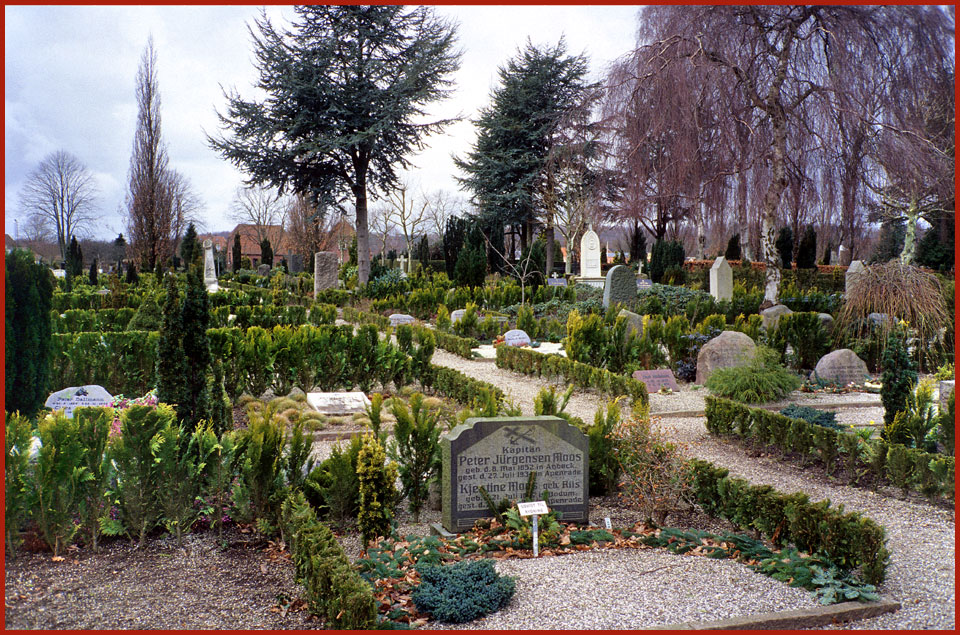
The old cemetery in Aabenraa
(Photography by Karsten Petersen)
- "The Gold Coast" -
-
a Very Special Cemetery -
----------------------
At first glance, the old cemetery in Aabenraa
looks pretty much like any other typical Danish provincial city cemetery.
However, - when taking a walk up and down
the paths between the grave sites, you cannot avoid to take note of the
many maritime decorations and symbols you can find on many of the tomb
stones.
This is unusual - - -
And when looking at the names on those stones,
you will find an amazing number of famous people resting here,- mostly
people from the glorious past -, highly skilled ship builders, - well known
Captains, and great ship owners,- all belonging to the very top in the
maritime field,- people who made history,- or at least made a difference!
For about two years ago, I told my good neighbour,
that I had just had a trip to Aabenraa in order to have a closer look at
the cemetery there. Of course he got very surprised, and simply had
to know why?
Not being very serious, I answered, that
Aabenraa cemetery actually was the one cemetery in the whole World, where
I knew most people! :-)
But when I think about it, this statement,-
which was just for fun -, is actually very, very true!
In fact, - Aabenraa cemetery really IS the
cemetery where I know most people!
Due to my interest in all things maritime,
I have over the years come across a lot of names of well known people in
the maritime trade, - and quite a lot of them are buried right there in
one of the great centres where it happened, - in Aabenraa!
And at one area of this cemetery, the graves of some of the most famous people from the maritime world are so close together, that to this day, the local people refer to this section as "The Gold Coast"!
So,- I got curious, and had to go and have
a look in order to see, what I could find - - -

The old cemetery in Aabenraa
(Photography by Karsten Petersen)
Here a panoramic view of the cemetery in Aabenraa.
Apparently not much maritime stuff here, but you have to look a little
bit closer,
Actually the tomb stone on the grave site
in the foreground of this picture, is that of a Sea Captain, - Captain
Peter Jurgensen Moos, (1852 - 1934). At the top of the stone, you
can just see the symbol of the cross and a ship's anchor crossing each
other,- a well known maritime symbol of faith and hope.
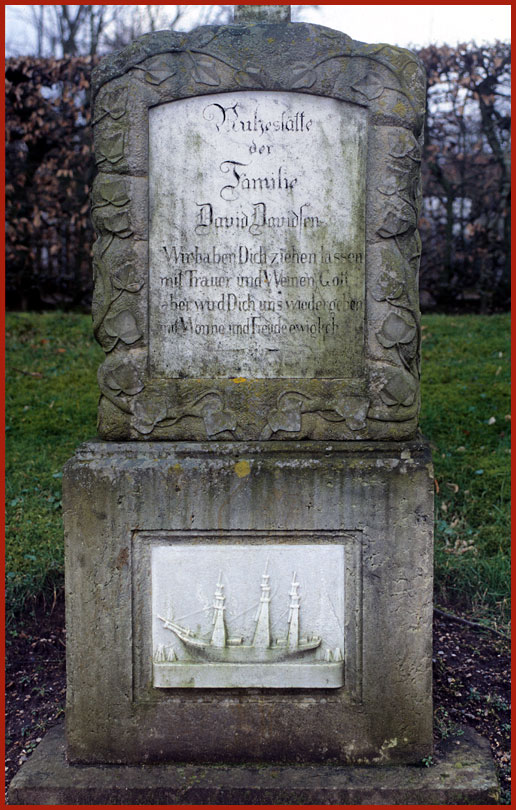
The Family Grave Site of Captain
David Davidsen.
(Photography by Karsten Petersen)
Here another tomb stone on a
Captains grave , - the family grave site of Captain David Davidsen (1847
- 1881).
You see a picture of a full
rigged ship! The top masts are taken down as well as the yard arms
and the whole running rigging! Furthermore it is very tightly moored to
4 heavy dolphins,- two forward and two aft! This ship is clearly
laid up, and NOT about to go to sea again! The symbolism is quite
clear! The old sailor resting here, has entered "port" and has been tied
up for the last time - - - -
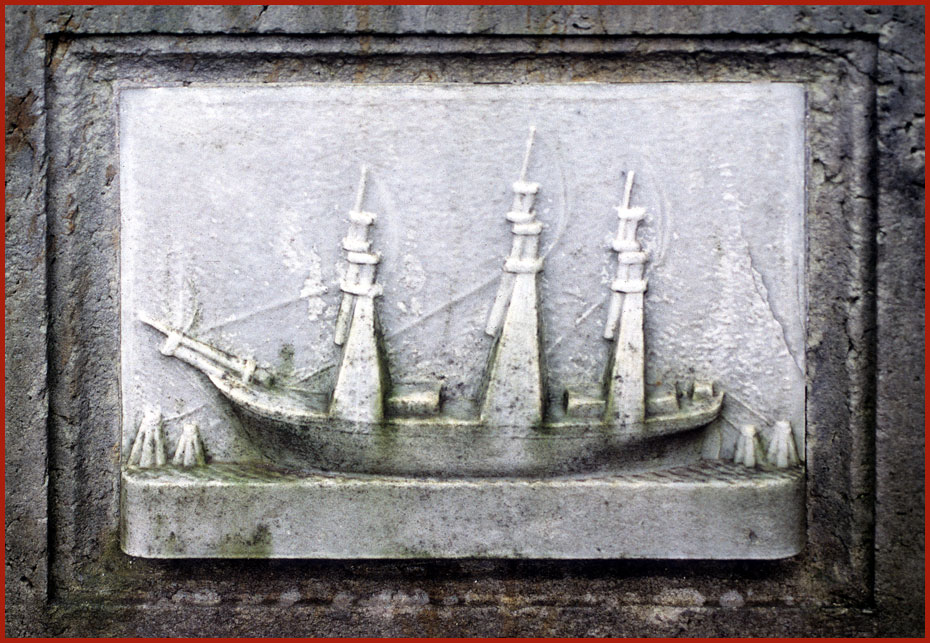
Here a closer look at the wonderful
ship picture on Captain Davidsens tomb stone!
Very similar decorations you
can see on many other graves in Aabenraa.
(Photography by Karsten Petersen)
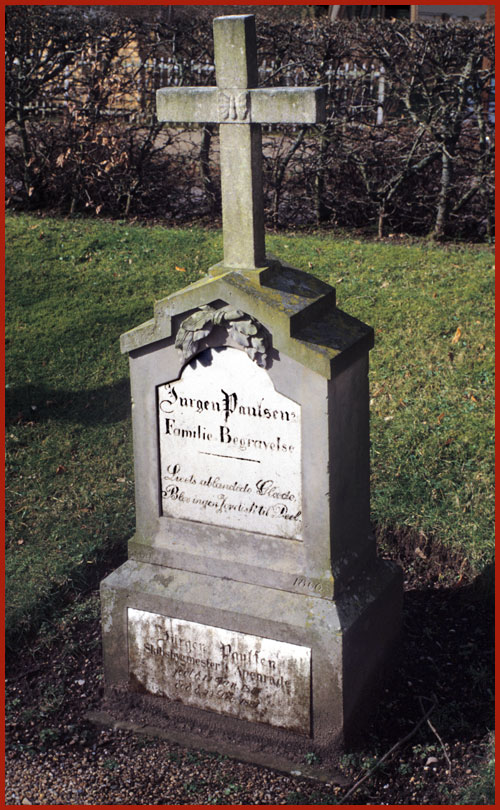
Here the grave site of one
of the real heavyweights from the maritime past of Aabenrraa.
This time not a Sea Captain,
but the well known ship builder Jurgen Paulsen. (1814 - 1881).
(Photography by Karsten Petersen)
Paulsen's yard was not only
the oldest ship yard in Aabenraa, but also the yard that stayed active
for the longest period of time.
It is during Jurgen Paulsens
time, that the shipbuilding industry in Aabenraa reached it peak,- and
Paulsen himself, belonged to the most wealthy people in town!
From 1786 and to 1883, the
yard turned out about 115 ships of all types and sizes, from gun boats
to large full rigged ships!

Here another sea related family
grave site.
A couple of Sea Captains of
the Schutt family rest here, - most likely brothers, - Captain Andreas
Schutt (1841 - 1880), - and Captain Peter Petersen Schutt (1838 - 1898),
- again with the typical picture of a laid up ship!
(Photography by Karsten Petersen)
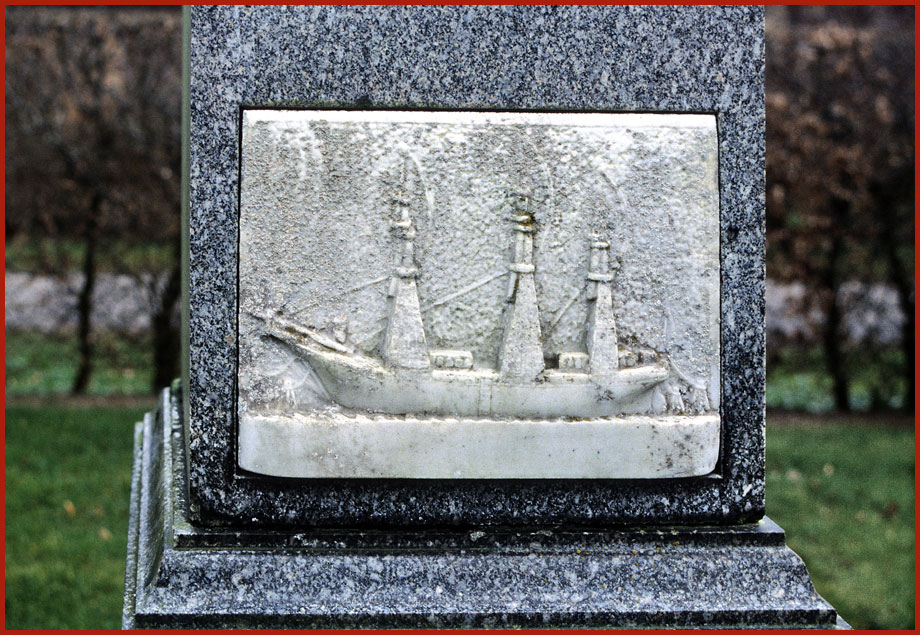
Here a closer view of the ship
decoration on the Schutt stone.
- the ship firmly tied up to
dolphins fore and aft - top masts taken down and yard arms removed -
(Photography by Karsten Petersen)
Here it is worth to take note
of a small detail. Above the forecastle you can see a special tube shaped
canvas duct which was used for catching the breeze to provide ventilation
of the decks below. Such a ventilation duct was of course only used when
the ship was in active service and in hot areas.
Tradition says, that if a laid
up ship is shown with such a ventilation duct, it indicates that the Captain
died in active service at sea.

And here the family grave site
of Captain Johann Caspar Koch (1789 - 1860).
(Photography by Karsten Petersen)
Again you see the laid up ship, safely moored at four dolphins,- and again you see the special ventilation duct,- this time mounted between the first two masts, indicating that the Captain died at sea.
See detailed picture below!
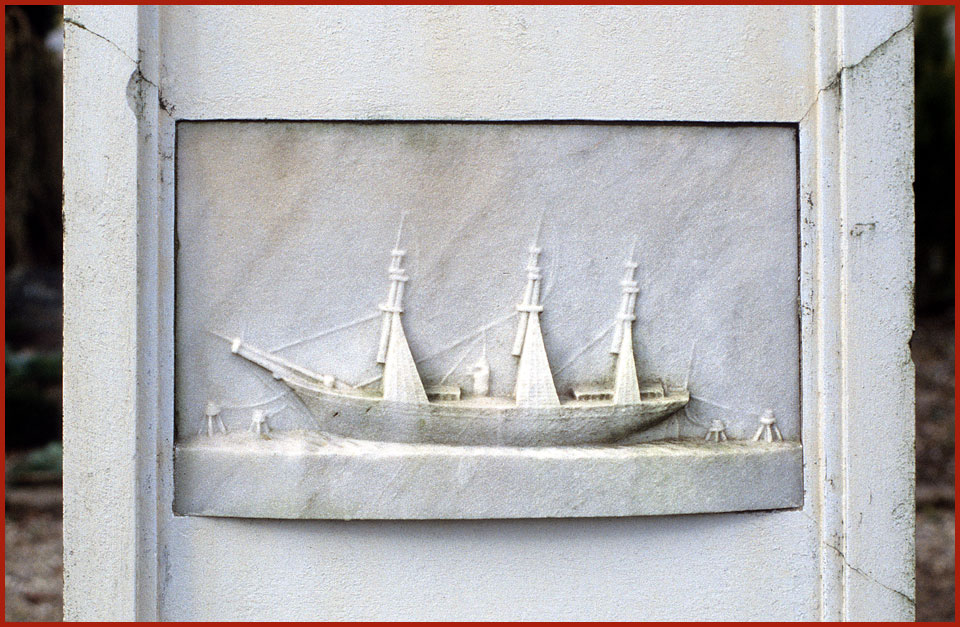
Detail of the Koch family tomb
stone, showing a laid up ship with a ventilation duct between the masts.
(Photography by Karsten Petersen)
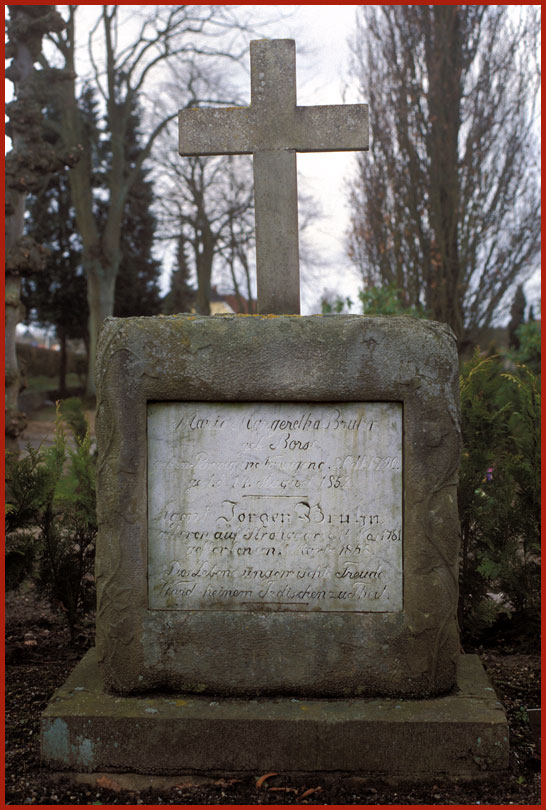
Here the tomb stone of Jørgen
Bruhn, - the greatest of them all.
(Photography by Karsten Petersen)
Jørgen Bruhn (1781 -
1858), - famous Sea Captain, ship builder and ship owner!
Take note of how small and
insignificant this grave site is,- and still it belongs to one of the mightiest
men in the Kingdom in those days - - -
Read more about Jørgen Bruhn, - his ships and his ship yard HERE .
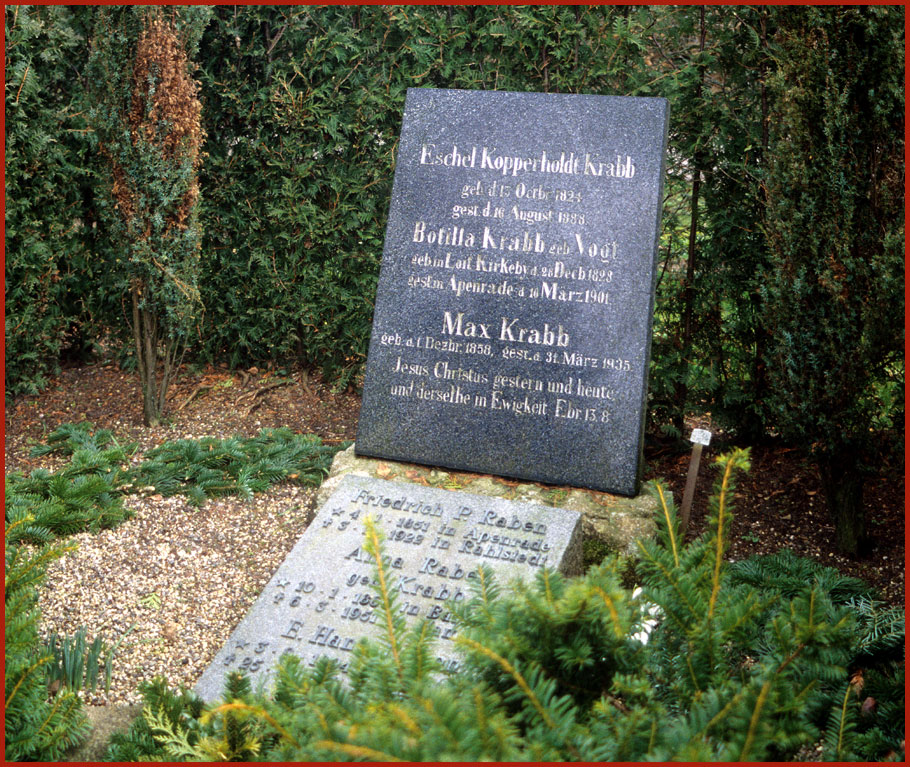
Here rests another famous sailor
that belonged to the very best during his time.
Sea Captain Eschel Krabb (1824
- 1888).
(Photography by Karsten Petersen)
Captain Krabb earned his good
reputation as Master on some of the fastest clipper ships of the time,
and as such he belonged to a small exclusive elite of highly respected
and experienced clipper ship Captains, that could virtually get a job anywhere
on any ship they wanted.

Here he is, - Captain Eschel
Kobberholdt Krabb -
- obviously photographed in
his glory days -
(Photography by ????)
Captain Krabb aimed for the
top,- and indeed he got there - - - Just look at this picture!
Here it is worth to mention,
that Captain Krabb in 1860 beat all previous speed records on the run from
Hong Kong to san Francisco, while he was Master on the barque "Creole".
Later Hans Bruhn, - son of
Jørgen Bruhn -, offered
Captain Krabb the command of the fastest ship of them all,- the clipper
ship "Cimber", but unfortunately the "Cimber"
was wrecked before he could take command of this famous "greyhound of the
seas".
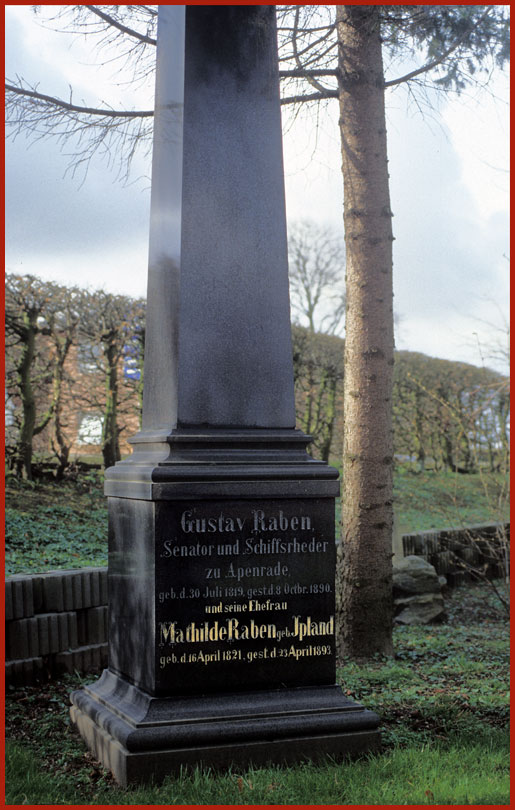
And now to another very well
known Captain, ship builder and ship owner, - Gustav Raben (1819 - 1890).
(Photography by Karsten Petersen)
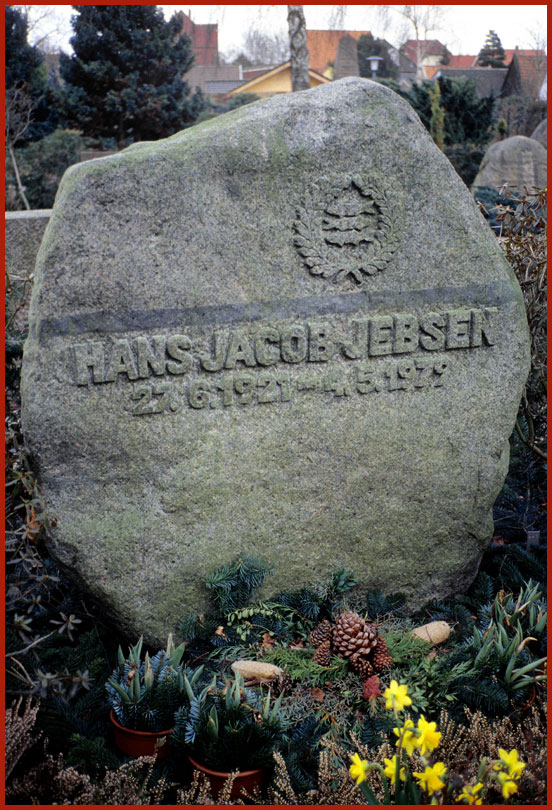
Here the resting place of a
very recent shipowner, - Mr. Hans Jacob Jebsen - (1927 - 1979) -
with a great and well known
historical family background -
(Photography by Karsten Petersen)
When talking about the great
maritime traditions of Aabenraa, you cannot avoid also to mention the Jebsen
company, which, - contrary to the other companies mentioned here -, exists
to this very day.
This grave site, - of Mr. Hans
Jacob Jebsen (1921 - 1979)-, made a special impression on me, since
I started to work for Jebsen & Co.
way back in 1972, when Mr. Hans Jacob Jebsen was the Senior Executive Manager
of the Shipping Department.
At that time I actually got
a chance to meet him and talk with him. I got employed as a Marine Engineer
on his newest ship, - the "EMMA
JEBSEN" , Denmarks last China trader -, and now, - so many
years after-, it is a little bit strange to stand in front of Mr. Jebsens
grave.
Again an example of a very modest
tomb stone
The only decoration is the
famous Jebsen logo, - "The 3 Mackerels" - - - (Of course! What else???)
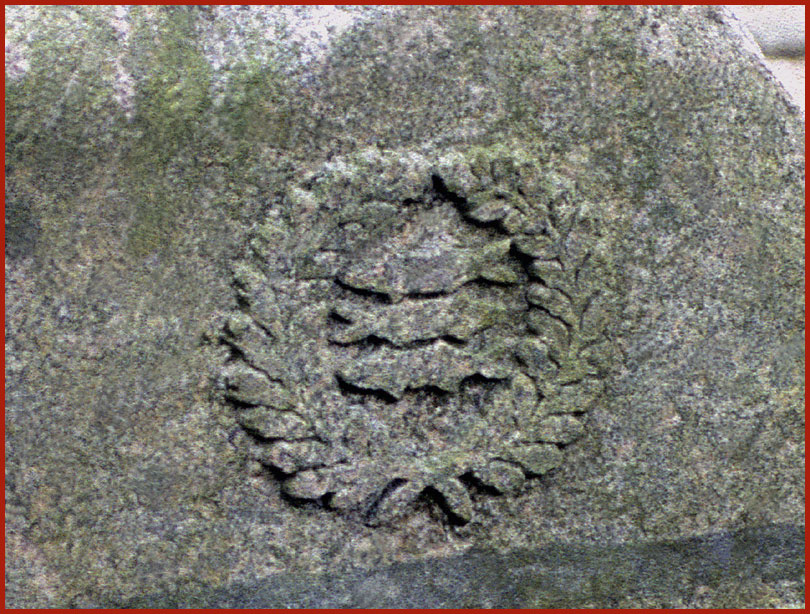
"The Three Mackerels" , - with
a garland of oak leaves around -
- this time carved in granite
-
(Photography by Karsten Petersen)
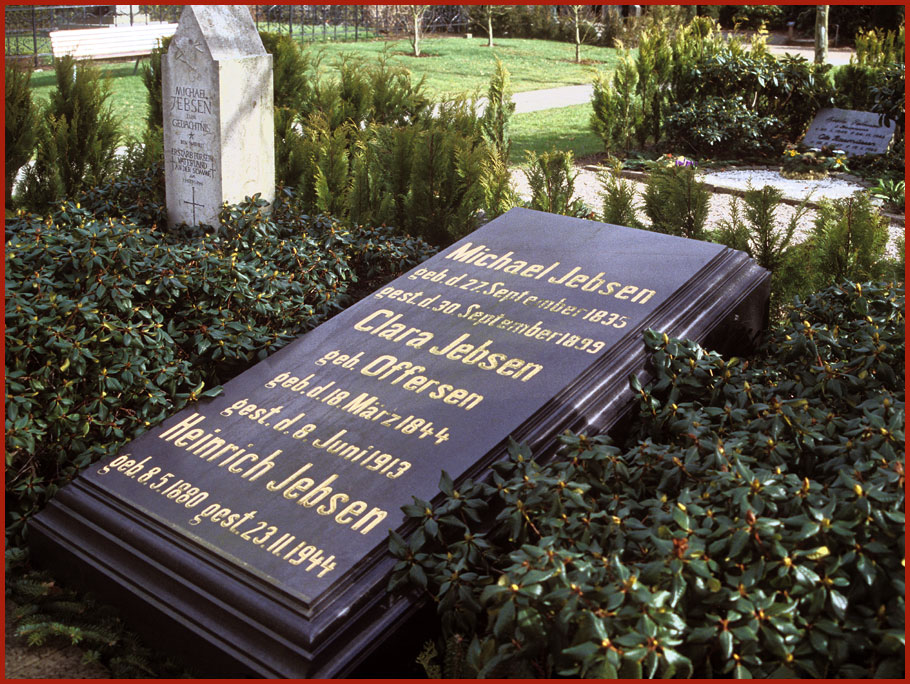
Finally,- here in this family
grave rests the founder of the well known Jebsen Company -
- Captain Michael Jebsen (1835
- 1899) -
(Photography by Karsten Petersen)
Michael Jebsen's father was
also a Sea Captain, so the Jebsen family has a long maritime tradition.
Surprisingly enough, there
are no maritime logos or decorations on this black marble stone, but to
each side of it stands a sand stone stele. On this picture you can only
see the left steele, but on the steele to the right, - which is a memorial
to Friedrich Jebsen (1881 - 1915), who died in the North Sea during
the First World War -, you can see a decoration showing a ships anchor
indicating the maritime connection.
Michael Jebsen was born in
Aabenraa in 1835 and went to sea in 1851 on the great sailing ships of
that time.
He passed the examination as
a navigator and soon became a mate and eventually Master. He served on
both sailing ships and steam ships, and like so many other Aabenraa sailors,
he also soon bought his own ship, and finally he ended up as a General
Manager of Alfred Krupps shipping company in Rotterdam.
In 1878 he founded his own
shipping company in Aabenraa, but contrary to all the other ship owners
in town, he clearly saw, that the future belonged to the steam ship.
And he was right!
His introduction of the steam
ship, proved to be such a great success, that just about 10 years later
his company operated a fleet of 13 steam ships, - mainly on the China Coast.
And the Jebsen Company has
been big out there ever since, with several thousand people employed on
offices all over Asia - - - -
SOME FINAL REMARKS:
To those readers who have not yet fallen
asleep, - it must have occured to them, that all the grave sites shown
on these pages are in fact very, very modest.
This is NOT because I have selected only
the modest looking grave sites, - and on purpose avoided the more impressive
and glorious looking monuments!
In fact there are no impressive and glorious
monuments for individual people at this cemetery, although there are some
war memorials of a certain magnitude.
This is a bit strange indeed, because you
would expect much more spectacular grave sites, at least for people like
Jørgen Bruhn, who was actually the biggest ship owner in Denmark,-
and highly respected.
Likewise the Jebsen grave sites are also
very plain and modest, taking into consideration that this family controlled,
- and still controls -, one the the biggest companies in Asia!
And you see the same pattern with the grave
sites of all the other famous ship builders, ship owners and Sea Captains.
All have relatively small and very modest
grave sites, and somehow it does not make sense!
How can that be????
Well,- of course I do not have the full answer
to that question, but being an old sailor myself, I have had some experiences
which might give at least some explanation to the fact, why those great
men from the maritime past, apparently had no desire of creating impressive
monuments to their own glory,- contrary to land based people, - like famous
politicians and Generals -, who all seem to love spectacular monuments
and meaningless medals.
I think that the modesty you find in people
with close connections to the sea, simply comes from that closeness to
nature that you can only experience on a ship at the middle of the great
ocean!
There is only endless stretches of water
around you, - and above you only stars in a sky with no limits!
You are right in the middle of the Universe
itself, - and it is a fantastic feeling - - - -
You sit there on your ship, which is like
an insignificant grain of dust in the middle of all that huge, endless
nature around you, and you know, that this nature can show such a fury,
that it can smash both you and your ship, just as easy as you can crush
an ant under your foot!
In other words,- you feel "small" and gradually
you realize how insignificant a human being really is in this huge, powerful
and endless universe that surrounds us!
You are only "star dust"!
Therefore there is no doubt, that a seagoing
man can change very much after many years at sea.
In fact he WILL change! It is unavoidable!
I clearly feel that myself.
It is typical, that many of those things
that people at home find extremely exiting and very important, in fact
has no meaning at all to a sailor! Knowing the World and having "felt"
the pulse of Universe itself, it seems that those things, that can easily
excite land-lubbers, are in fact far too small and insignificant to a sailor,
and I am quite sure, that this phenomenon can be very difficult, - or even
impossible -, to understand for most land-lubbers!
The special culture you once found in places
like Aabenraa and other great maritime centres, was of course heavily influenced
by the great number of sailors who lived in those communities.
Therefore I have reasons to believe, that
this special "understanding" and "sailor modesty", that was learned on
the great oceans, naturally transferred to the surroundings ashore, - and
eventually to the grave sites.
This "understanding" and modesty of a simple
sailor did not of course not just fade away when that simple sailor went
ashore to became a major ship owner or a gifted ship constructor!
The modesty once learned at sea, stayed with
him for life,- and in death!
Therefore a great burial site with a huge
and impressive monument has no value to him!
The fruit of their work, - which they left
for generations to come -, which we can all enjoy to this day, that indeed
are the real monuments to their honour.
And that might explain why the tomb stones
for those great men appear to be so modest in spite of their great achievements!
Back to "Aabenraa"
Back to "The Ships"
Page initiated: Dec.09.2004
Page updated: Jan.15.2008
Jan.16.2008